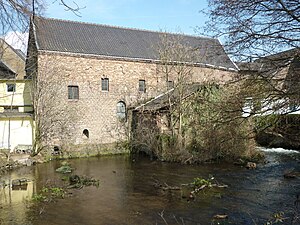Kenten mill
| Kentener Mühle (also: Adelsmühle)
|
||
|---|---|---|
|
Kentener mill from the waterfront |
||
| Location and history | ||
|
|
||
| Coordinates | 50 ° 56 '51 " N , 6 ° 39' 8" E | |
| Location | Bergheim - Kenten | |
| Waters | Erft (Small Erft) | |
| Status | The structure and mill wheel have been preserved | |
| technology | ||
| use | ||
| drive | Watermill | |
| water wheel | 1 × medium-sized (previously 2) |
|
The Kentener Mühle is a listed watermill on the Kleine Erft in the Kenten district of the district town of Bergheim in the Rhein-Erft district .
history
Grain was ground in the Kentener Mühle until 1962. An oil press ran parallel to this until 1928. In its beginnings, the Kentener Mühle probably belonged to the castle of the noblemen of Kenten, in whose immediate vicinity it was located. It was a water mill on the Kleine Erft and is first mentioned in 1358. Baron Johann Sigismund Raitz von Frentz acquired the mill in 1711 and leased it. At that time it was named "Rulandsmühle" after the previous owners. In 1766 the miller Gottfried Kolping bought the mill. Until then he had been the tenant of Eschermühle. Until the beginning of the 20th century, ownership of the Kentener Mühle was passed on to the Kolping family. The new owner was then in 1910 Heinrich Oebel, who bought the property from the mayor Franz Kolping. He was followed in 1921 by Peter Greve, whose descendants still live on the mill today.
The water wheel and the weir were restored in 1997 with the financial support of the preservation authorities. The Kentener Mühle is one of the large mills on the Erft, which is also documented in the fact that the mill and residential buildings are separated from each other.
architecture
In 1837 the Kentener mill had two grinding aisles, a pearl barley, two oil presses and two medium-sized water wheels (today one). When the oil mill was not used for grinding oil, it was used as a plaster mill. The plaster of paris was used as fertilizer. The actual mill building is integrated into a courtyard with an approximately pentagonal floor plan. It was built around 1800 using older components. The new building goes back to Gottfried Kolping. The two and a half storey brick building has a gable roof and a wheel house for the mill wheel facing the mill pond. The mill wheel has a diameter of about four meters and is made of sheet steel with screw connections. It is still occasionally set in motion today so that it does not expire. Two weir systems regulate the flow of water to the mill wheel. The grinder has been preserved with ancillary equipment (cleaning and processing machines), only the grinding stones are missing. The house, a two-storey plastered brick house, adjoins the mill building at an acute angle. The entrance area is in the middle of the five-axis facade. Anchor pins reveal the year of construction: 1781. The door and upper door frames and the door leaf also refer to the time of construction.
monument
The Kentener mill is a registered monument and found the monument number 24 in the list of monuments in Kenten again.
literature
- Heinz Andermahr, Helmut Schrön, Ralph Jansen: Bergheim City Guide District Town Bergheim (ed.), Bergheim 2011, ISBN 978-3-9801975-7-1 .
- Walter Buschmann : The Kentener mill in Bergheim (with pictures 2006) online at rheinische-industriekultur.de
Individual evidence
- ↑ Brief description from Mühlenverband Rhein-Erft-Ruhr (PDF; 873 kB)



